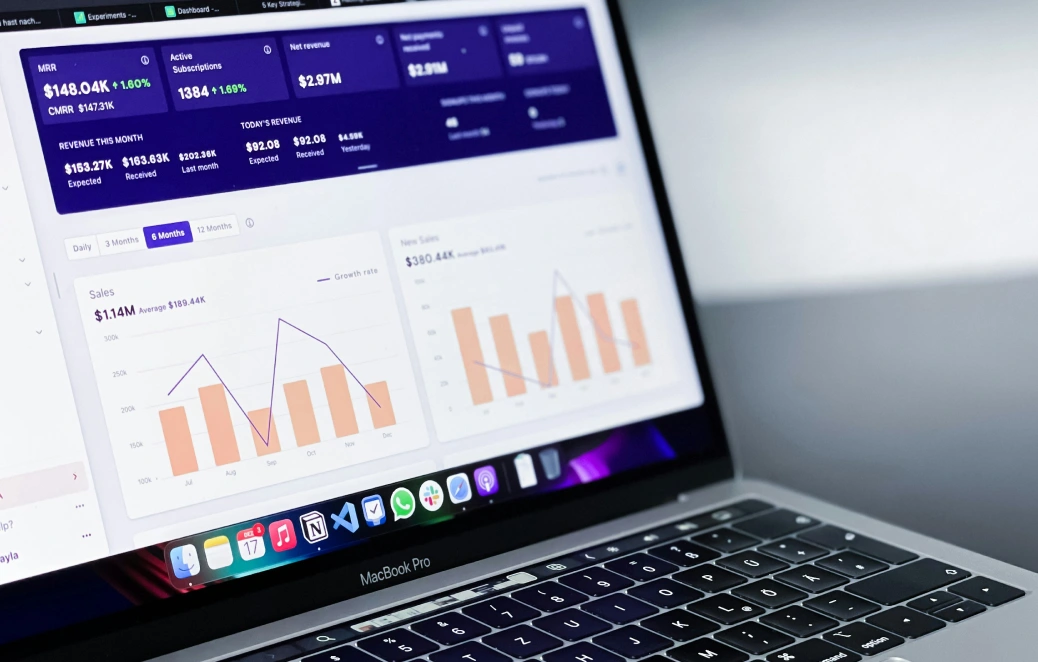Guide to Measure ROI for Your Company Conference

Chief Executive Officer

Measuring ROI for a company conference is essential to justify expenses and improve future events. Conferences can cost tens of thousands of dollars, and without clear metrics, it's hard to prove their value. ROI isn't just about revenue - it also includes brand awareness, lead generation, employee engagement, and long-term business relationships. Here’s how you can measure and improve ROI effectively:
- Set Clear Goals: Define what success looks like (e.g., leads generated, customer retention, or brand visibility).
- Track Financial ROI: Use metrics like revenue growth, lead conversions, and cost savings.
- Measure Non-Financial ROI: Assess brand awareness, employee morale, knowledge gained, and networking outcomes.
- Collect and Analyze Data: Use tools like event management platforms, surveys, and CRM systems to gather insights.
- Connect ROI to Business Outcomes: Link event activities to tangible results like sales pipeline impact or customer satisfaction.
- Improve Future ROI: Focus on attendee engagement, leverage technology, and implement strong follow-up strategies.
To calculate ROI, use the formula: ROI = (Net Profit / Total Investment) × 100. For example, if your conference cost $165,000 and generated $250,000 in revenue, your ROI is 51.5%. Don’t forget to include indirect benefits like brand exposure and employee engagement when presenting results. By following these steps, you can ensure every dollar spent on conferences delivers measurable value.
New To Events? Measure Results This Way
What ROI Means for Corporate Events
When we talk about return on investment (ROI) for corporate events, it’s not just about the dollars and cents. Sure, financial gains are important, but conference ROI goes far beyond that. It includes long-term benefits like boosting brand recognition, enhancing employee morale, and building relationships that can open doors down the road. In fact, a whopping 72% of event organizers believe that in-person events are a key part of their marketing strategy.
"Our report illustrates that the meetings and events industry continues to grow across all segments as it contributes hundreds of billions of dollars in revenue to the U.S. economy and supports 5.9 million jobs." - Adam Sacks, Founder and President of Tourism
Measuring ROI for conferences isn’t one-size-fits-all. Some outcomes, like lead generation and sales conversions, are easy to track with numbers. Others, such as brand awareness or relationship building, take a more qualitative approach and often unfold over time. This broader perspective allows for a mix of methods to evaluate both direct financial returns and the less tangible, but equally important, strategic benefits.
Here’s a powerful stat to chew on: for every dollar spent on face-to-face meetings and events, the U.S. economy sees an additional $1.60 in benefits. That’s a 160% return - a clear example of how investing in conferences can ripple across various aspects of business performance.
How to Measure Financial ROI
Financial ROI focuses on the bottom line - revenue growth and cost savings. Metrics like lead generation, conversion rates, and direct sales provide a snapshot of the event’s immediate financial impact. These numbers are critical for understanding the tangible outcomes of your investment.
How to Measure Non-Financial ROI
But let’s not stop at the dollars. Non-financial ROI captures the strategic, long-term benefits that are often the foundation for future success. These are the intangibles that may not show up on a balance sheet right away but still play a pivotal role in your business’s growth.
- Brand awareness and visibility: Track social media activity like mentions, hashtag usage, and photo shares, as well as website traffic and media coverage during and after the event. These metrics help gauge how far your message is reaching.
- Employee engagement and satisfaction: Happy, motivated employees can be a game-changer. Surveys conducted before and after the event can reveal shifts in job satisfaction, alignment with company goals, and morale - factors that indirectly boost retention and productivity.
- Knowledge transfer and skill development: Conferences are often about learning. Use post-event surveys, certifications, or new processes discussed at the event to measure how much valuable knowledge your team gained.
- Relationship building and networking: The connections made at events can lead to future collaborations. Track new contacts, follow-up meetings, and partnerships to see the impact of networking efforts.
Recent data shows that 45% of event organizers focus on attendee engagement, 38% on attendance, and 35% on budgets. This trend highlights that the quality of engagement often outweighs sheer attendance numbers when evaluating a conference’s success.
Finally, don’t overlook customer satisfaction and loyalty. Delivering valuable content and memorable experiences can deepen relationships with existing clients, reduce churn, and increase their lifetime value to your business.
Setting Clear Goals and Key Performance Indicators (KPIs)
Once you've acknowledged the importance of measuring ROI, the next step is to establish clear goals and KPIs. Before diving into conference planning, you need to define exactly what you aim to achieve. Without specific goals and measurable KPIs, tracking ROI becomes nearly impossible. Successful conferences always begin with well-defined objectives that directly tie into meaningful business outcomes.
Think of your goals as the blueprint for your entire event. They determine which metrics to track, what data to gather, and how to measure success. Be as specific as possible so that everyone on your team understands the targets.
Connecting Event Goals to Business Results
Your conference goals should align seamlessly with your broader business objectives. Start by identifying your key business challenges or opportunities. Are you trying to break into new markets, generate qualified leads, improve customer retention, launch a new product, or establish your company as a thought leader?
For instance, if lead generation is a top priority, your conference goal might focus on collecting a significant number of qualified leads with clear buying intent. On the other hand, if customer retention is your focus, you could aim to enhance customer satisfaction through direct engagement and exclusive experiences.
When your event goals are closely tied to business outcomes, every activity becomes a strategic driver. The real value of your conference emerges when you can connect its activities directly to tangible business results.
While financial goals are often easier to define, don't overlook strategic objectives like boosting brand awareness or increasing employee engagement. These are equally important in evaluating the overall success of your event.
Picking the Right KPIs to Track
Once your objectives are set, the next step is to identify KPIs that accurately reflect those goals. The most effective KPIs are specific, measurable, and aligned with your objectives. They should also be practical to track using the tools and resources you have.
Start with attendance metrics. Go beyond just counting registrations - track actual attendance and session participation to gauge audience engagement. This gives you a clearer picture of how involved your attendees are.
If your event is designed to drive business development, focus on lead generation KPIs. Measure the number of qualified leads collected, assess their quality, and track follow-up interactions to evaluate the event's impact.
Engagement metrics are another critical area. Keep an eye on session ratings, Q&A participation, networking activities, and social media interactions to understand how well your content resonates during and after the event.
Digital metrics can extend your insights even further. Monitor website traffic, social media mentions, content downloads, and email list growth to measure your event's broader reach.
For financial ROI, sales and revenue KPIs are key. Track how many deals were influenced by the event, the value added to your sales pipeline, and the revenue generated within a specific timeframe. You can also measure average deal size and the length of the sales cycle for leads generated at the conference.
Finally, don't forget about brand awareness indicators like media coverage, social media reach, and sentiment analysis. While these metrics might not show immediate results, they can provide valuable insights into the long-term impact of your event.
Gathering and Analyzing Event Data
Capturing event data is a process that begins before your conference kicks off and continues long after it wraps up. The goal is to establish multiple points of contact throughout the event's lifecycle to collect a mix of measurable metrics and personal feedback. This combination forms the foundation for understanding your event's performance and calculating ROI.
Start by gathering baseline data during registration. Track details like registration trends, attendee demographics, company sizes, job roles, and geographic distribution. This provides a solid framework for analyzing engagement across different audience segments.
During the event itself, focus on real-time data collection. Keep tabs on session attendance, monitor networking activity, and track social media engagement as it happens. This immediate feedback not only offers valuable insights but also allows you to make on-the-spot adjustments to enhance the attendee experience.
After the event, follow up promptly - ideally within 48 to 72 hours - while the event remains fresh in attendees' minds. Continue tracking business outcomes over the following weeks and months to assess the long-term impact of your efforts.
Tools for Collecting Data
Event management platforms act as your central hub for data. Modern systems automatically gather attendee information, track session participation, and compile engagement metrics. Many platforms also include built-in analytics dashboards to simplify data interpretation.
Survey tools are key for collecting qualitative feedback. Use pre-event surveys to gauge expectations, pulse surveys during the event to measure satisfaction, and post-event surveys to evaluate overall impact. To ensure high response rates, keep surveys concise and focused on the most critical insights.
Mobile event apps offer detailed engagement data. They can track which sessions attendees attend, how long they stay, what content they download, and who they connect with during networking. Push notifications and in-app messaging also provide additional insights into attendee behavior.
Social media monitoring tools help you understand the broader conversation around your event. Track mentions, hashtags, and sentiment on platforms like LinkedIn, Twitter, and Instagram. This data can reveal how your event influences brand awareness and thought leadership.
Lead capture systems are essential for tracking business development. Whether you’re using badge scanners, QR codes, or digital business cards, make sure you’re collecting both contact details and contextual information about interactions. This helps identify which sessions or activities generated the most qualified leads.
Website analytics show how your event drives online engagement. Monitor traffic spikes during and after the event, track content downloads, and measure email sign-ups. Use UTM parameters for event-specific links to isolate conference-related activity from other marketing efforts.
Sales CRM integration connects the dots between event interactions and business outcomes. Tag leads generated during the conference and track their journey through your sales pipeline. This is critical for calculating the financial ROI of your event.
How to Analyze Data for ROI Insights
Break down your data by factors like company size, industry, job role, and location. This segmentation helps you identify which audience groups were the most engaged and which generated the highest-quality leads.
Compare your results to the KPIs you set during the planning stage. Look for patterns that explain variations in performance. For instance, if certain sessions had higher engagement, dig into what made them stand out - was it the topic, the speaker, or the timing?
Create an engagement score by combining metrics such as session attendance, networking activity, content downloads, social media interactions, and survey responses. This composite score provides a more complete view of your event’s impact.
Follow the customer journey from registration through post-event follow-up to identify where engagement peaked or dropped. Use this information to refine your approach and focus resources on the activities that drive the most value.
Benchmark your results against past events and industry standards. Instead of only focusing on individual event outcomes, look for trends over time. This broader perspective helps you understand whether your ROI is improving and highlights areas for improvement.
Evaluate the quality of leads by scoring them based on factors like company size, decision-making authority, budget, and interest level. Often, a smaller pool of highly qualified leads delivers better ROI than a large number of unqualified contacts.
Tie event data to business results by tracking leads through your sales funnel. Measure conversion rates, deal sizes, and sales cycle lengths for event-generated leads compared to other sources. This analysis provides a direct link to ROI and supports future event planning.
Finally, use cohort analysis to track the longer-term impact of your event. Follow groups of attendees over time to see how their engagement evolves and how business relationships develop. Often, the most valuable outcomes from a conference emerge months later. These insights will help you calculate ROI more accurately and refine your strategy for future events.
sbb-itb-ae35a94
Calculating ROI and Sharing Results
Now that you've gathered the event data, it's time to translate those insights into clear, actionable ROI metrics. By accurately calculating ROI and presenting the results effectively, you can demonstrate the true value of your conference investment and guide future decisions.
How to Use the ROI Formula
The core ROI formula is simple: ROI = (Net Profit / Total Investment) × 100. Applying this to conferences, however, requires considering both direct and indirect benefits, as well as short- and long-term outcomes.
Start with your total investment, which includes both direct costs - like venue fees, catering, and speaker expenses - and indirect costs. For example, if your event costs $150,000 and you incur an additional $15,000 in indirect expenses, the total investment comes to $165,000. If the event generates $250,000 in revenue, your net profit is $85,000, resulting in an ROI of (85,000 / 165,000) × 100 = 51.5%.
But conferences often provide more than just immediate financial returns. Factors like brand awareness, customer retention, and employee engagement also contribute to ROI, though they require different measurement methods. For instance, you can use industry benchmarks or your company’s historical data to estimate these benefits.
For long sales cycles, use attribution models to assign partial credit to your event. If a $100,000 deal closes nine months after the conference and the event was one of five customer touchpoints, you could attribute 20% of the deal’s value - $20,000 - to your conference ROI.
Building an ROI Report
An ROI report bridges the gap between event activities and business outcomes. To make it impactful, structure your report to cater to different stakeholders while maintaining a clear and logical flow.
Start with an Executive Summary, keeping it concise - ideally one page. Highlight the headline ROI figure and include three to four key takeaways that show the event’s business impact. Add a brief note on your methodology to establish credibility without overwhelming readers with excessive details.
Break down your costs by category and present both quantitative and qualitative results. Use visuals like charts and graphs to make data easier to digest, and compare the current event’s performance with past data to highlight trends.
The Results and Outcomes section is the core of your report. Use visuals to present data clearly, such as charts showing lead generation by session, audience engagement scores, or conversion timelines. These visuals help stakeholders quickly grasp the event’s impact.
Incorporate attendee feedback to add a personal touch to your findings. Include quotes that reflect the event’s value, such as insights about business connections or long-term relationship building. Balancing positive feedback with constructive criticism shows objectivity and a commitment to improvement.
Your Methodology section should explain how you calculated ROI, the assumptions you made, and any limitations in your analysis. Transparency here builds trust and helps stakeholders understand the reliability of your conclusions.
Wrap up with Future Recommendations, linking insights to actionable next steps. For instance, if a particular session drove significant engagement, suggest expanding similar content in future events. If certain audience segments showed higher conversion rates, recommend targeting them more heavily next time.
Throughout your report, use visual storytelling to simplify complex data. Infographics that map the attendee journey from registration to conversion or before-and-after charts can quickly communicate key metrics and trends.
Tailor your presentation for different audiences. For example:
- Board members may focus on high-level ROI and strategic insights.
- Marketing teams will want a detailed breakdown of lead quality and conversion rates.
- Sales leadership is likely to prioritize pipeline impact and deal attribution.
Consider adding interactive dashboards to your reporting toolkit. These allow stakeholders to explore the data themselves, filtering results by time period, audience segment, or content type. This not only deepens engagement but also equips decision-makers with the insights they need for future planning.
Finally, document your findings and lessons learned. This not only showcases the event’s impact but also provides a roadmap for improving future conferences.
Ways to Improve ROI for Future Conferences
To build on the ROI analysis framework, improving future conference ROI requires actionable steps that focus on technology, engagement, and follow-up. By integrating smart tools, fostering deeper attendee involvement, and following up strategically, event interactions can translate into measurable business results. Here’s how to make it happen.
Using Technology to Boost ROI
Technology can elevate a conference from a one-off event to a powerful business development platform. Tools like event management software simplify registration and provide real-time data insights, enabling smarter decisions during the event.
Mobile apps are another game-changer. They allow attendees to create personalized schedules, network more effectively, and participate in live polls. These features help identify high-interest sessions and key networking opportunities.
Live streaming and hybrid event options can significantly broaden your event's reach without adding substantial costs. Virtual attendance ensures that those unable to attend in person can still participate, increasing your audience size and lead-generation potential.
AI-powered tools take things a step further by recommending relevant connections among attendees. Real-time analytics also allow you to make immediate adjustments, like reallocating resources to popular sessions, ensuring the event delivers maximum value.
Getting More Attendee Engagement
Engaged attendees are more likely to transform into qualified leads and long-term business partners. To boost engagement:
- Move beyond traditional lectures by incorporating interactive formats like workshops, panel discussions, and collaborative sessions. These activities encourage active participation and leave a lasting impression.
- Add gamification elements, such as points for attending sessions or visiting booths. Features like leaderboards and prizes can make the event more dynamic and fun while driving engagement with key areas.
- Personalize the experience by offering tailored content tracks for different attendee segments. This approach ensures participants can focus on the topics most relevant to them.
- Organize structured networking activities, such as speed networking or roundtables, to help attendees form meaningful connections.
- Leverage social media by encouraging attendees to share their experiences using an event-specific hashtag. This not only increases engagement but also amplifies your event’s visibility across professional networks.
Better Post-Event Follow-Up Methods
A strong follow-up strategy is essential for turning event interactions into tangible business outcomes. The period immediately after a conference is your chance to maintain the momentum and solidify connections.
Segment follow-up campaigns based on where attendees are in the buyer’s journey. For instance, send demo invites to prospects and nurturing content to general attendees.
Extend the event’s value by sharing key presentations, session recordings, and exclusive resources. This reinforces your messaging and keeps attendees engaged.
Collecting meaningful feedback is another critical step. Go beyond basic satisfaction surveys to ask targeted questions about content relevance, networking opportunities, and which aspects of the event influenced their decisions. This feedback not only helps refine future events but also demonstrates ROI to stakeholders.
Aligning sales and marketing teams ensures that leads generated during the event are properly followed up on. Set clear processes for lead scoring and response times to turn initial interactions into long-term business relationships.
Lastly, establish ongoing nurturing campaigns through email series, targeted content, and future invitations. Use CRM systems to track attribution, connecting post-event actions to eventual customer conversions. This approach highlights the long-term impact of your conference investment.
Conclusion: Using ROI Measurement to Justify Event Spending
Measuring the return on investment (ROI) for conferences lays the groundwork for smarter decision-making around corporate events. By following the structured approach outlined here, you can move beyond gut instincts and anecdotal feedback to build a strong, data-driven case for future event spending.
The framework provided focuses on establishing clear financial and non-financial goals before the event, then using the right tools to gather meaningful data during and after the experience. It's important to remember that ROI isn't just about immediate revenue - it also reflects factors like brand exposure, lead quality, employee morale, and long-term relationship growth.
When done right, ROI calculations clearly connect conference activities to measurable business outcomes. A well-prepared ROI report not only simplifies the process of securing budgets for future events but also helps identify which aspects of your event deliver the highest returns. This ensures you’re making the most of every dollar spent and continuously improving your approach to maximize results.
Key elements of a successful ROI strategy include leveraging technology, driving engagement, and implementing thoughtful follow-ups. Together, these elements amplify the impact of your events, turning them into tools for generating measurable and lasting value for your organization.
Think of ROI measurement as an evolving process. Each event provides insights that can help refine your strategy, test fresh ideas, and improve outcomes over time. By adopting this systematic approach, corporate events shift from being seen as expenses to becoming strategic investments that fuel growth, foster relationships, and align with your organization’s broader goals.
With a focus on clear objectives, reliable data, and actionable insights, your ROI measurement process will grow stronger with every event. Companies that consistently showcase strong ROI from their conferences are the ones that continue to secure funding for impactful events. By embracing these practices, you’re positioning your events - and your organization - for long-term success in a competitive business environment.
FAQs
What are the best ways to measure non-financial ROI from a company conference?
To evaluate the non-financial return on investment (ROI) of a company conference, focus on metrics that go beyond dollars and cents. Key areas to assess include attendee engagement, satisfaction, and brand visibility. Start by using post-event surveys to gather feedback about the overall experience. A great tool for this is the Net Promoter Score (NPS), which measures how likely attendees are to recommend the event to others - a solid indicator of loyalty and event impact.
You can also look at qualitative outcomes. For instance, did the event spark meaningful business connections? Were there actionable insights or takeaways that participants found valuable? On the digital side, monitor social media activity, including mentions, event hashtags, and attendee interactions. These metrics can paint a vivid picture of how the event resonated with your audience and its influence on your brand's reach.
By combining these strategies, you'll get a clearer sense of the conference's success beyond just financial gains, offering a more comprehensive view of its overall value.
What are the best tools to collect and analyze data for measuring conference ROI?
To gauge the return on investment (ROI) from your conference, leveraging the right tools can make all the difference. CRM systems like Salesforce are great for tracking leads and revenue, while business intelligence platforms such as Tableau help uncover data trends. If you're looking to gather attendee feedback or measure engagement, tools like SurveyMonkey or Google Forms can provide valuable insights. Additionally, event management platforms with built-in analytics and real-time dashboards simplify monitoring metrics like attendee satisfaction and brand visibility.
These tools let you measure both the concrete results, such as revenue and lead generation, and the less tangible benefits, like boosting brand awareness. With this data in hand, you’ll be better equipped to make informed decisions and get the most out of your corporate events.
How can I make sure our conference goals align with overall business objectives to achieve the best ROI?
To ensure your conference aligns with business objectives and delivers a strong return on investment (ROI), start by establishing SMART goals - goals that are Specific, Measurable, Achievable, Relevant, and Time-bound. These should tie directly to your company’s strategic priorities to keep your efforts both focused and trackable.
Involve key stakeholders early in the planning process to confirm that your goals align with broader organizational priorities and to secure their buy-in. Make it a point to revisit and refine these goals regularly, especially if there are shifts in your company’s strategy or performance metrics. Staying adaptable while keeping your focus sharp will help your conference drive meaningful outcomes and contribute to your company’s success.
Related Blog Posts









